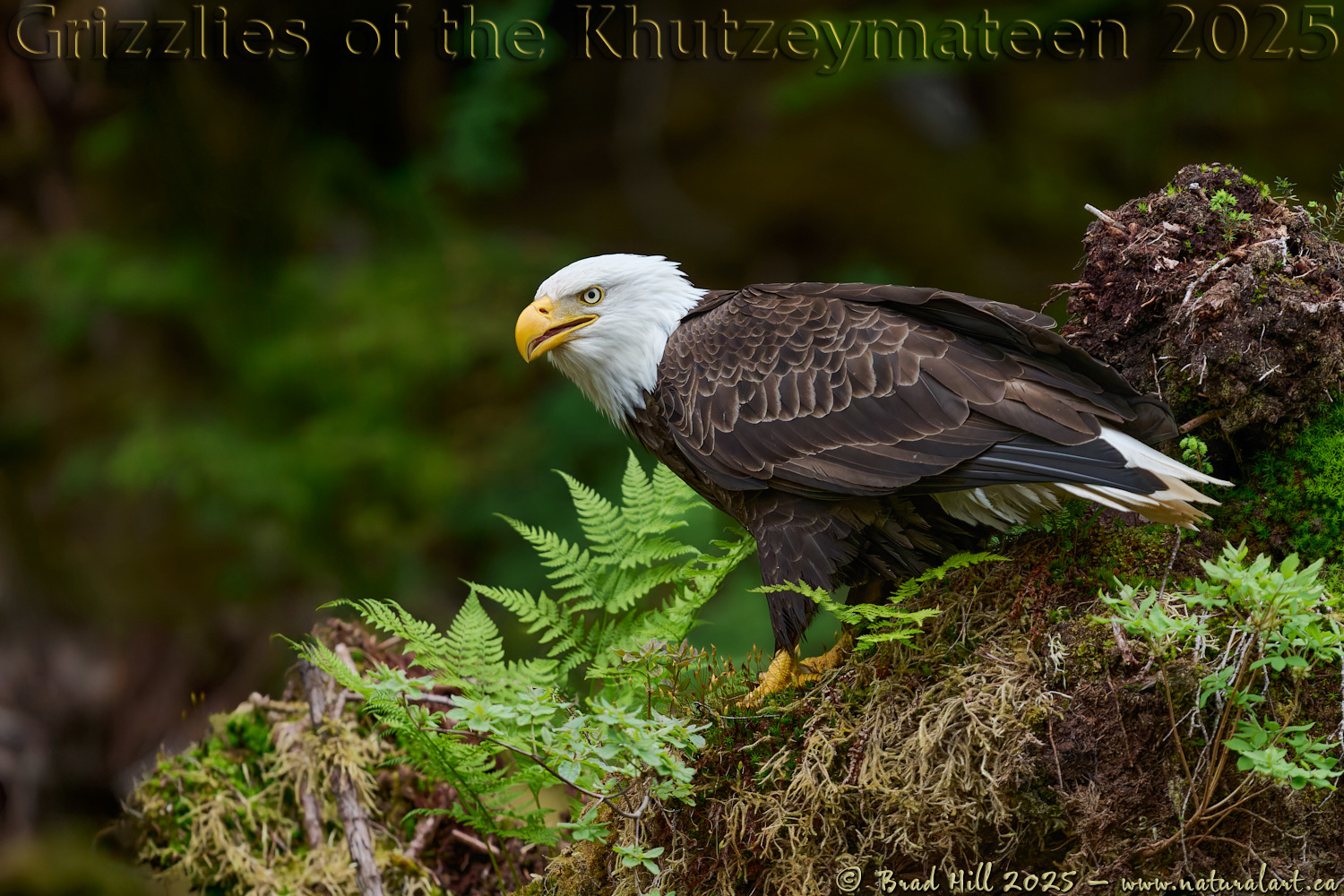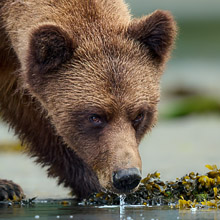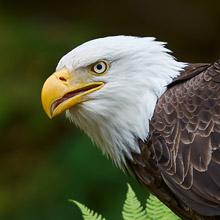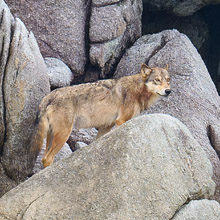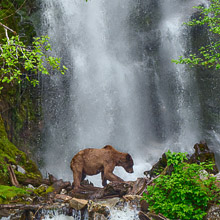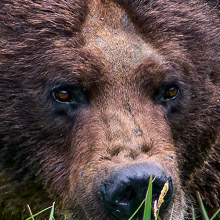Availability: Undetermined - Enquiries?
In the Field
Poised & Posed. Khutzeymateen Inlet, British Columbia, Canada. May 24, 2025.
Even though most folks go to the Khutzeymateen Grizzly Sanctuary to see and photograph the bears, there IS other wildlife subject matter there! Over the years I've photographed coastal Gray Wolves, Northern River Otters, Harbour Seals, and several other species in the Khutzeymateen. And...it can be a GREAT place to photograph Bald Eagles. Over the years I've captured close-ups, action and flight shots, and even animalscapes (eaglescapes?) of Bald Eagles in the Khutzeymateen. This eagle allowed us to approach quite closely as it munched on the remnants of a white bird (very likely an unlucky Short-billed Gull).
I captured this image using a Nikon Z 9 with a Nikkor Z 400mm f2.8S lens with its built-in TC engaged (so at 560mm). Like with the majority of Z-lenses, the Z 400mm f2.8S is very sharp shot wide open, even with its TC engaged. This image was captured at f4 (wide open).
Here's a larger version (4800 pixel) of this near perfect poser:
• Poised & Posed: Download 4800 pixel image (JPEG: 5.6 MB)
ADDITIONAL NOTES:
1. These images - in all resolutions - are protected by copyright. I'm fine with personal uses of them (including use as desktop backgrounds or screensavers on your own computer), but unauthorized commercial use of the image is prohibited by law. Thanks in advance for respecting my copyright!
2. Like all photographs on this website, these images were captured following the strict ethical guidelines described in The Wildlife FIRST! Principles of Photographer Conduct. As such, no baiting or any form of attractant was used and, as always, we attempted to minimize our impact on the ongoing behaviour of the subjects. I strongly encourage all wildlife photographers to always put the welfare of their subjects above the value of their photographs.
3. This image was captured during my Grizzlies of the Khutzeymateen instructional photo tour in late spring of 2025. Each year I offer trips into the Great Bear Rainforest as well as tours into the Khutzeymateen Grizzly Sanctuary (to photograph grizzlies, of course!). Details about these trips can be found on the Photo Tours page of this website.
Behind the Camera
Poised & Posed. Khutzeymateen Inlet, British Columbia, Canada. May 24, 2025.
High Efficiency* Compressed RAW (NEF) format; ISO 3600.
Nikon Z 9 paired with Nikkor Z 400mm f2.8S @ 560mm (TC engaged). Hand-held from a floating Zodiac inflatable boat. VR on in Sport mode. 3D-tracking AF area mode with subject detection on "Birds" mode.
1/3200s @ f4; -1.0 stop compensation from matrix-metered exposure setting.
At the Computer
Poised & Posed. Khutzeymateen Inlet, British Columbia, Canada. May 24, 2025.
Initial noise reduction and capture sharpening on the .nef (raw) file using the DeepPRIME XD2S algorithm of DXO PhotoLab 8.7 Elite (using the appropriate lens/camera optical module).
Subsequent adjustments to the adjusted linear DNG file (exported from PhotoLab) and conversion to 16-bit TIFF file (and JPEG files for web use) - including all global and selective adjustments - made using Capture One Pro (build 16.6.3). In the case of this image the only global adjustments were tweaks to the blacks and highlights. Selective local adjustments performed using Capture One Pro's layers and masking tools. In this case numerous small adjustments and minor tweaks were made on 4 separate layers, with the tweaks being associated with "exposure balancing" and contrast adjustments (such as adjustments to brightness, clarity, highlights, shadows, etc.).
Photoshop modifications included insertion of the watermark and/or text.
Conservation
Poised & Posed. Khutzeymateen Inlet, British Columbia, Canada. May 24, 2025.
Species Status in Canada - Bald Eagle*: This species is not designated as at risk. The Bald Eagle was listed as "Endangered" in the contiguous US states from 1967 to 1995. In 1995 it was downlisted to "Threatened". On June 28, 2007 Bald Eagles were removed from the list of endangered and threatened species - a true American conservation success story.
The Bald Eagle (Haliaeetus leucocephalus) is a very large bird of prey with broad wings. Adults possess characteristic white ("bald") heads. It takes Bald Eagles a full five years to attain their characteristic adult plumage (including their nearly pure white head and tail). In the years prior to the development of their adult plumage they are easy to confuse with Golden Eagles. Being very broad-winged Bald Eagles are able to use an energy-efficient flapping-soaring style of flight. While many people like to think of the Bald Eagle as a fierce hunter, in reality they hunt only as a last resort. More commonly they scavenge for their prey. Additionally, they often klepto-parasitize other weaker species such as Osprey, commonly stealing the other species hard-earned prey items. The Bald Eagle is, of course, the national emblem of the United States (Benjamin Franklin argued against this - his preference was for the Wild Turkey).
*as determined by COSEWIC: The Committee on the Status of Endangered Wildlife in Canada













